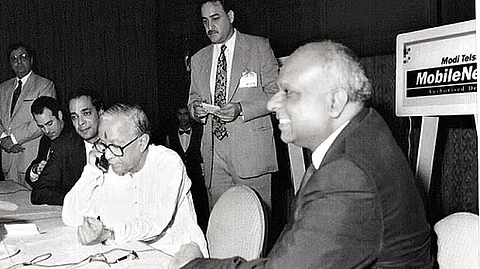
- Home
- न्यूजग्राम
- India
- World
- Politics
- Entertainment
- Culture
- Lifestyle
- Economy
- Sports
- Sp. Coverage
- Misc.
- NewsGram Exclusive
- Jobs / Internships

On July 31, 1995 India's first-ever mobile phone call occured.
The historic call was made between Chief Minister Jyoti Basu and Union Communications Minister Sukh Ram
The call was made using a Nokia handset
On July 31, 1995, India witnessed a landmark moment in its communication history—the first-ever mobile phone call in the country. The call was made between West Bengal Chief Minister Jyoti Basu and Union Communications Minister Sukh Ram, marking the beginning of mobile telephony in India. This milestone paved the way for a technological revolution that has transformed the nation’s telecommunications landscape over the past 29 years.
The historic call connected the Writer’s Building in Calcutta (now Kolkata) with Sanchar Bhavan in New Delhi, facilitated through Modi Telstra’s MobileNet service. This was a joint venture between India’s B.K. Modi Group and Australia’s Telstra, combining resources to establish India’s first mobile network.
The call was made using a Nokia handset, symbolizing the start of a new era of wireless communication in a country where telephony had been limited to landline connections for decades.
At the time, mobile phone services were considered a luxury, affordable only to a select few. Call charges were significantly high compared to today’s standards, ₹8.4 per minute for both incoming and outgoing calls, and during peak hours, the cost could rise to ₹16.8 per minute. Such steep tariffs limited mobile phone usage mainly to businesspersons, political leaders, and affluent sections of society.
The 1995 call marked the beginning of a mobile revolution that would eventually transform India into the world’s second-largest telecom market by subscribers. Over the years, technological advancements and increased competition drastically reshaped the telecom industry. In the late 1990s to early 2000s, mobile services expanded to more cities, though call rates remained high. By the mid-2000s, the introduction of prepaid plans made mobile phones more affordable and accessible to the middle class. Post-2010, the rise of smartphones and the availability of affordable internet began redefining digital communication. Finally, in 2016, Reliance Jio disrupted the market with low-cost data plans and free voice calls, making mobile services accessible to millions across the country.
Today, most telecom recharge plans focus primarily on data usage, with voice calls offered for free or at negligible costs. Plans often include unlimited calling, daily SMS limits, and bundled internet access, making mobile connectivity essential and affordable for millions.
The first mobile phone call in India was not just a technological feat but also a turning point for the country’s socio-economic development. It opened doors for mass communication on the go, breaking barriers of distance and accessibility. Laid the foundation for India’s rapid digitalization and growth of the telecom sector. Paved the way for innovations such as smartphones, mobile banking, digital payments, and widespread internet penetration. [Rh/Eth/VP]
